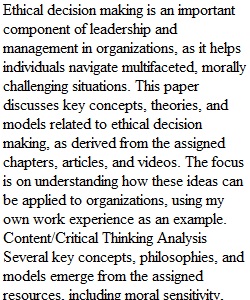


Q You will develop a short paper (2-3 pages) indicating understanding and perceptions of key content points from assigned chapters, articles, videos, etc. Papers will include: • Title/cover page • Introduction (2 paragraphs maximum) • Content/Critical Thinking Analysis (Identify key concepts, theories, and models from weekly assigned chapters and readings [Topic: Ethical Decision Making] and describe how you can apply this information to your organization-give examples) • Conclusion (2 paragraphs maximum) • References • Note: You can use your current/former work organization (or an organization you may volunteer for, serve on committees, etc.) Papers will be mostly narrative in format. See the rubric for specific details to guide you in developing your papers. Papers must follow APA guidelines (especially in regards to citing sources to avoid plagiarized work). You will utilize content from the textbook, and any additional resources, such as scholarly articles, journals, books, assigned videos. (Note: Wikipedia is not a scholarly resource). Rubric COB Graduate Written Assignment Rubric COB Graduate Written Assignment Rubric Criteria Ratings Pts This criterion is linked to a Learning OutcomeContent 20 to >19.0 pts Distinguished Reveals a solid understanding of the proposed topic as evidenced by preliminary research and knowledge. 19 to >17.8 pts Proficient Identifies significant details of the proposed topic. Reveals an adequate understanding of the topic as evidenced by the amount of preliminary research. 17.8 to >16.6 pts Satisfactory Reveals a restricted understanding of the proposed topic. 16.6 to >14.8 pts Marginal Adds little detail to describe the proposed topic. 14.8 to >0 pts Unsatisfactory Does not identify the proposed topic. 20 pts This criterion is linked to a Learning OutcomeOrganization 20 to >19.0 pts Distinguished Well developed paragraphs. Sequencing enhances ideas and meaning. Ideas focused on central theme. 19 to >17.8 pts Proficient Smooth transition between paragraph with adequate structure and sequencing of ideas. 17.8 to >16.6 pts Satisfactory Transition between most paragraphs with limited paragraph structure. Sequence is not logical. 16.6 to >14.8 pts Marginal Some transition with poor paragraph structure and some evidence of planning. 14.8 to >0 pts Unsatisfactory No transition between paragraphs, ideas not in logical order. No structure to paragraphs. 20 pts This criterion is linked to a Learning OutcomeDevelopment 20 to >19.0 pts Distinguished Ideas focus on the central theme. All ideas are clearly presented and unified. 19 to >17.8 pts Proficient Central theme is matched to the topic, most ideas explore the central theme, clear and unified. 17.8 to >16.6 pts Satisfactory Ideas are clear. Some ideas address the central theme. Central theme is linked to the topic. 16.6 to >14.8 pts Marginal Few idea address central theme. Ideas ramble and are difficult to identify. 14.8 to >0 pts Unsatisfactory Does not follow the theme with muddles unclear ideas. 20 pts This criterion is linked to a Learning OutcomeConventions 20 to >19.0 pts Distinguished No errors noted. 19 to >17.8 pts Proficient 1 error -sentence structure -capitalization -grammar -presentation -general structure 17.8 to >16.6 pts Satisfactory 2-3 errors -sentence structure -capitalization -grammar -presentation -general structure 16.6 to >14.8 pts Marginal 4-5 errors -sentence structure -capitalization -grammar -presentation -general structure 14.8 to >0 pts Unsatisfactory Multiple errors -sentence structure -capitalization -grammar -presentation -general structure 20 pts This criterion is linked to a Learning OutcomeAPA Style 20 to >19.0 pts Distinguished No errors noted. 19 to >17.8 pts Proficient 1 error -cover page -in text citations -reference page -general format 17.8 to >16.6 pts Satisfactory 2-3 errors -cover page -in text citations -reference page -general format 16.6 to >14.8 pts Marginal 4-5 errors -cover page -in text citations -reference page -general format 14.8 to >0 pts Unsatisfactory Several errors in: -cover page -in text citations -reference page -general format 20 pts Total Points: 100 PreviousNext
View Related Questions